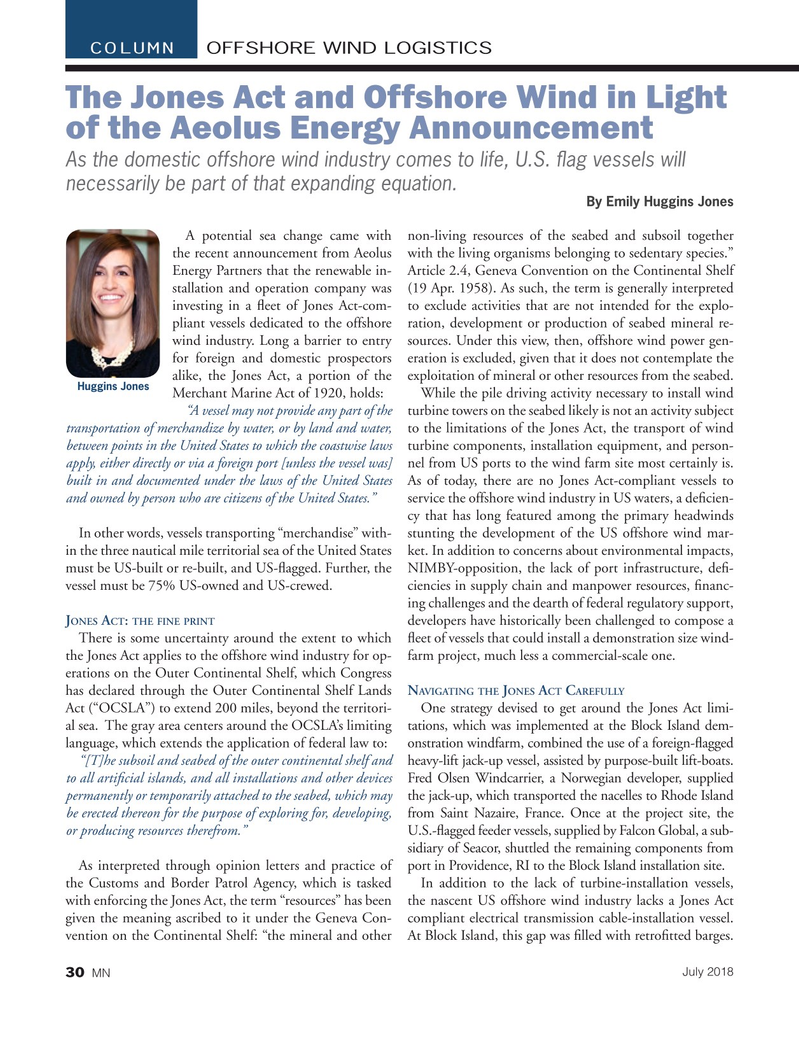
Page 30: of Marine News Magazine (July 2018)
Propulsion Technology
Read this page in Pdf, Flash or Html5 edition of July 2018 Marine News Magazine
COLUMN OFFSHORE WIND LOGISTICS
The Jones Act and Offshore Wind in Light of the Aeolus Energy Announcement
As the domestic offshore wind industry comes to life, U.S. ? ag vessels will necessarily be part of that expanding equation.
By Emily Huggins Jones
A potential sea change came with non-living resources of the seabed and subsoil together the recent announcement from Aeolus with the living organisms belonging to sedentary species.”
Energy Partners that the renewable in- Article 2.4, Geneva Convention on the Continental Shelf stallation and operation company was (19 Apr. 1958). As such, the term is generally interpreted investing in a ? eet of Jones Act-com- to exclude activities that are not intended for the explo- pliant vessels dedicated to the offshore ration, development or production of seabed mineral re- wind industry. Long a barrier to entry sources. Under this view, then, offshore wind power gen- for foreign and domestic prospectors eration is excluded, given that it does not contemplate the alike, the Jones Act, a portion of the exploitation of mineral or other resources from the seabed.
Huggins Jones
Merchant Marine Act of 1920, holds: While the pile driving activity necessary to install wind “A vessel may not provide any part of the turbine towers on the seabed likely is not an activity subject transportation of merchandize by water, or by land and water, to the limitations of the Jones Act, the transport of wind between points in the United States to which the coastwise laws turbine components, installation equipment, and person- apply, either directly or via a foreign port [unless the vessel was] nel from US ports to the wind farm site most certainly is. built in and documented under the laws of the United States As of today, there are no Jones Act-compliant vessels to and owned by person who are citizens of the United States.” service the offshore wind industry in US waters, a de? cien- cy that has long featured among the primary headwinds
In other words, vessels transporting “merchandise” with- stunting the development of the US offshore wind mar- in the three nautical mile territorial sea of the United States ket. In addition to concerns about environmental impacts, must be US-built or re-built, and US-? agged. Further, the NIMBY-opposition, the lack of port infrastructure, de? - vessel must be 75% US-owned and US-crewed. ciencies in supply chain and manpower resources, ? nanc- ing challenges and the dearth of federal regulatory support,
J A : developers have historically been challenged to compose a
ONES CT THE FINE PRINT
There is some uncertainty around the extent to which ? eet of vessels that could install a demonstration size wind- the Jones Act applies to the offshore wind industry for op- farm project, much less a commercial-scale one. erations on the Outer Continental Shelf, which Congress has declared through the Outer Continental Shelf Lands N J A C
AVIGATING THE ONES CT AREFULLY
Act (“OCSLA”) to extend 200 miles, beyond the territori- One strategy devised to get around the Jones Act limi- al sea. The gray area centers around the OCSLA’s limiting tations, which was implemented at the Block Island dem- language, which extends the application of federal law to: onstration windfarm, combined the use of a foreign-? agged “[T]he subsoil and seabed of the outer continental shelf and heavy-lift jack-up vessel, assisted by purpose-built lift-boats. to all arti

 29
29

 31
31
